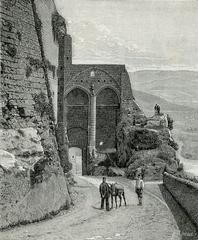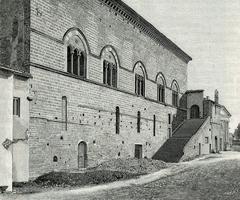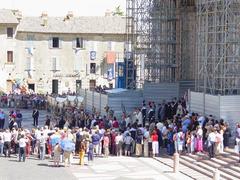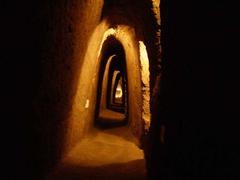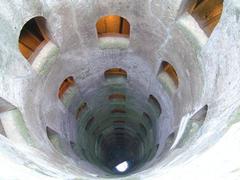Castello di Corbara Visiting Hours, Tickets, and Orvieto Historical Sites Guide
Date: 14/06/2025
Introduction
Set amid the rolling hills of Umbria, just a short distance from the historic city of Orvieto, Castello di Corbara is a remarkable destination that seamlessly blends centuries of Italian history, medieval architecture, and a dynamic tradition of wine production. With origins stretching back to at least the late 13th century, this medieval castle and estate has evolved from a Roman-era strategic outpost to a contemporary center for sustainable viticulture and cultural events. Overlooking the Tiber Valley, Castello di Corbara offers visitors not only sweeping views of Orvieto and Todi but also a unique opportunity to immerse themselves in the layered history and agricultural heritage of Umbria.
Celebrated today for its Orvieto DOC wines and preservation of ancient grape biotypes, the estate is a living testament to the region’s enduring spirit. Visitors can explore fortified walls, expansive vineyards, and historic grounds, while enjoying guided tours, tastings, and seasonal events that celebrate the best of Umbrian gastronomy and tradition. This comprehensive guide provides all the essential information for planning your visit—including hours, ticketing, accessibility, travel tips, and nearby attractions—to ensure a memorable experience at one of Umbria’s most captivating sites (Castello di Corbara History; Corbara Online; Official Website).
Table of Contents
- Historical Overview
- Visitor Information
- Estate Experience
- FAQs
- Visual Gallery
- Plan Your Visit
- References
Historical Overview
Origins and Strategic Role
The Castello di Corbara area was significant long before the medieval period. Archaeological excavations, funded by the Banca Romana in the 19th century, uncovered the Roman port of Pagliano at the confluence of the Paglia and Tiber rivers, underscoring the region’s importance in ancient trade and viticulture (Castello di Corbara History). The presence of wine amphorae from this period highlights a winemaking tradition that continues today.
The first official documentation of Corbara as a “castrum” (fortified settlement) appears in the 1292 land register, marking its established role as a defensive stronghold and agricultural hub in medieval Umbria.
The Montemarte Family and Medieval Era
The Montemarte family played a central role in the region’s history. After losing their ancestral castle, the Montemartes settled in Corbara and Titignano, becoming influential figures in regional politics and military affairs (Corbara Online). Chronicles by Francesco di Montemarte provide valuable insights into the turbulent 14th century, including feudal skirmishes and alliances. In 1369, for example, Perugian forces retaliated against Count Ugolino di Montemarte’s papal allegiance by devastating Corbara’s vineyards and fortifications.
Feudal Conflicts and Notable Events
The late 14th century was marked by recurring conflicts. After Count Ugolino’s death in 1388, the estate faced repeated raids, including a major attack in 1389 led by Ranallo Medrato and Bartolomeo da Prato. Local defenders, however, successfully repelled invasions and rebuilt, illustrating the resilience of both the castle and its inhabitants. Diplomatic resolutions, such as the truce signed after Medrato’s death, highlight Corbara’s ongoing role in regional affairs (Corbara Online).
Architectural Evolution
The castle’s present form is the product of centuries of adaptation. Medieval defensive features—walls, towers, and keeps—were gradually complemented by noble residences and agricultural outbuildings as the estate transformed from fortress to manor (Corbara Online). Today, the estate’s C-shaped layout, northern tower, and elegant loggia reflect this layered architectural history (Corbara Online).
Modern Revival and Contemporary Significance
In the late 19th and 20th centuries, Castello di Corbara underwent significant transformations, culminating in the revival of its vineyards and hospitality services in the 1970s and 1990s. The Patrizi family’s stewardship brought renewed focus on sustainable agriculture, preservation of ancient grape varieties, and cultural programming (Castello di Corbara History). Today, the estate balances tradition and innovation, making it a vibrant center for wine production and tourism.
Visitor Information
Visiting Hours and Ticketing
- Hours: Open by appointment, typically Tuesday to Sunday, 10:00 AM – 6:00 PM. Seasonal variations apply; always confirm current hours on the official website.
- Ticket Prices: Standard guided tours with wine tasting start from €25–€35 per person. General admission for historical visits typically ranges from €10–€15, with discounts for children, seniors, and groups.
- Booking: Advance reservation is strongly recommended for tours, tastings, and accommodation. Book via the official site or by phone/WhatsApp: +39 351 327 1369.
Accessibility
Castello di Corbara strives to accommodate visitors with mobility needs. While the estate features some uneven terrain and historic structures, accessible paths and assistance are available upon request. Contact the estate before your visit to discuss specific requirements.
Travel Tips and Best Seasons
- Best Time to Visit: Spring (April–June) and early autumn (September–October) offer mild weather and vibrant vineyard scenery. The grape harvest (vendemmia) in late September is especially popular.
- Getting There: The estate is about 15 km from Orvieto and easily reachable by car. Limited public transport is available from Orvieto, but car rental or organized tours are recommended.
- Dress Code: Wear comfortable footwear for vineyard walks. Layered clothing is advisable due to temperature variability between indoor and outdoor areas.
Nearby Attractions and Amenities
- Orvieto: Renowned for its Gothic cathedral, Etruscan heritage, and medieval old town (Orvieto Tourism).
- Todi: Medieval town with historic squares and panoramic views.
- Natural Sites: Explore Lake Corbara and the Parco Fluviale del Tevere.
- Dining and Accommodation: On-site farmhouse restaurant “Il Caio” and a range of accommodation options from castle rooms to country villas.
Events, Tours, and Experiences
- Guided Tours: Multilingual tours cover the estate’s history, architecture, and winemaking process.
- Special Events: Seasonal wine harvests, truffle hunting, culinary classes, and private celebrations are available by arrangement (Wineries Experience).
Estate Experience
Wine Production and Cellar Tours
Castello di Corbara is distinguished for its Orvieto Classico and Superiore DOC wines, particularly Grechetto, Sangiovese, and Thybris Lago di Corbara DOC Sangiovese (Wineries Experience). Visitors can tour the vineyards and cellars, learning about both traditional and modern winemaking. Tasting sessions, typically featuring four estate wines paired with regional delicacies, are a highlight of the visit (winetourism.com).
Culinary Offerings and Hospitality
The estate’s farmhouse, Il Caio, is the center for Umbrian culinary experiences. Menus emphasize local ingredients—cured meats, artisanal cheeses, seasonal produce, handmade pastas, and estate olive oil. Dining options range from formal lunches to vineyard picnics and farm-to-table dinners.
Special Activities
- Truffle Hunting: Guided excursions with expert foragers and dogs, followed by truffle-infused tastings.
- Wellness: Yoga among the vines, nature walks, and relaxation treatments.
- Private Events: Weddings, retreats, and custom experiences can be organized for groups and families.
Frequently Asked Questions (FAQ)
Q: What are the visiting hours of Castello di Corbara?
A: By appointment, typically Tuesday–Sunday, 10:00 AM–6:00 PM. Confirm on the official website.
Q: How can I purchase tickets for tours and tastings?
A: Reserve online via the estate’s website or contact by phone/WhatsApp.
Q: Are children and families welcome?
A: Yes, many activities are family-friendly, and the estate grounds are ideal for exploration.
Q: Is Castello di Corbara accessible for visitors with disabilities?
A: The estate makes efforts to accommodate mobility needs; inquire in advance for specific arrangements.
Q: Can I visit the interior of the castle?
A: Interior access may be limited; the estate grounds, cellars, and vineyards remain the primary attractions (iluoghidelsilenzio.it).
Q: Are tours available in English and other languages?
A: Yes, multilingual guides are available.
Q: Can I combine my visit with Orvieto’s historical sites?
A: Absolutely. The estate is close to Orvieto’s Duomo, Torre del Moro, and Etruscan sites. Staff can assist with local excursion planning (Following the Rivera).
Visual Gallery
Explore images and virtual tours on the estate’s gallery page, featuring views of the medieval walls, vineyards, cellar, and panoramic landscapes. Alt text for images includes terms like “Castello di Corbara visiting hours,” “tickets,” and “Orvieto historical sites” for accessibility and search optimization.
Plan Your Visit
-
Contact:
- Phone: +39 351 327 1369
- Email: [email protected]
- Official Website
-
Booking:
Reserve your tour, tasting, or accommodation online or by phone. Group and private experiences are available. -
Travel Resources:
Download the Audiala app for personalized guides, event updates, and curated itineraries. Follow Castello di Corbara and Audiala on social media for the latest news and tips.
References and Further Reading
- Castello di Corbara History
- Corbara Online
- Official Website
- Wineries Experience
- Travelers Universe
- Il Uoghi del Silenzio
- Wine Tourism
